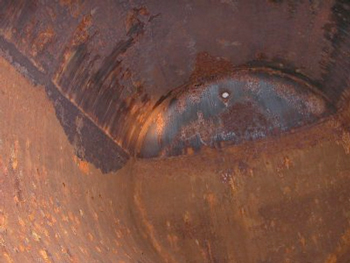 |
|
Please note: This summary is provided to help you understand the regulations. Consult the references provided for links to the full text of the regulations.
The wastewater generated when tanks are cleaned contains residues of whatever was in the tank. Since many of these materials can have harmful effects when released into the environment, the disposal of tank cleaning wastewater is governed by federal rules. Different rules apply to trucks, railcars, and interior barges on the one hand, and maritime vessels on the other. Regulations impacting interior tank cleaning have been promulgated by U.S. EPA and the U.S. Coast Guard. Other types of cleaning operations are covered elsewhere on TERC, including:
Who is covered by the regulations? Most tank interior cleaning operations are covered by EPA effluent guidelines, including truck, rail, and barges or ships when discharging to a publicly owned treatment works (POTW) or waters of the U.S. (e.g., lakes, steams, rivers, intercoastal waters and territorial seas). U.S. Coast Guard regulations apply to all U.S. flagged ships anywhere in the world and to all foreign flagged vessels operating in the navigable waters of the U.S., or while at a port under U.S. jurisdiction. The wastewater flows covered by regulations include all contact washwaters which have come into direct contact with a tank or container interior. This includes pre-rinse cleaning solutions, chemical cleaning solutions, and final rinse solutions. What is the purpose of the regulations? The primary pollutant output of tank cleaning operations is wastewater contaminated with tank residues (e.g., petroleum products, coal, organic chemicals, inorganic chemicals, compressed gases, fertilizers, pesticides, food products, paints, inks, glues, soaps) and cleaning solutions. These pollutants degrade water bodies and have adverse effects on marine life. Interior tank cleaning can be performed either at carrier or shipper-owned facilities or at a tank cleaning service facility (commonly called Transportation Equipment Cleaning Industry or TECI). The process used can differ significantly depending on the residues to be cleaned and the extent to which a tank needs to be cleaned prior to reuse. Most truck, barge and ship tanks are in dedicated service (i.e., carries one commodity only), however, a significant number are non-dedicated and must be cleaned after every trip to prevent contamination of materials from one cargo to the next. The following tank cleaning procedures are typically carried out at tank cleaning facilities:
Washing is performed either manually with hand held sprayers, or automatically with high pressure spinner nozzles or "butterworths." The volumes of water used, the types of wastes generated, and the cleaning time can vary widely. Option 1 - Discharge to a POTW Before you initiate option 1, you must acquire a permit or written notification from either your local sewer district or state environmental agency. You will also have to meet certain rules found in federal and state regulations, including:
To meet sewer discharge standards, you may need to install equipment such as an oil/water separator to prevent oil and sludge from being discharged to the sewer. This is referred to as "pretreatment." The oil and sludge collected by pretreatment equipment will have to be periodically removed and disposed of, possibly as a hazardous waste (you must make a hazardous waste determination). Other types of treatment that are commonly employed with wastewater include pH adjustment, settling, and metals precipitation processes. For more information see Pretreatment Standards and Limits. Option 2 - Discharge to a Stream Maritime rules (administered by the U.S. Coast Guard). The International Convention for the Prevention of Pollution from Ships ("MARPOL" short for marine pollution) is the international treaty regulating disposal of wastes generated by normal operation of vessels. MARPOL 73/78 is implemented in the U.S. by the Act to Prevent Pollution from Ships, under the lead of the U.S. Coast Guard. Cargo hold interiors are predominantly cleaned at sea by the tanker crew, with wastewater either discharged shore side at ballast water treatment facilities or at sea within the provisions of the MARPOL. A relatively small percentage of cargo hold interiors are cleaned shore side to facilitate inspection and repair and are performed concurrently with ballast tank and bunker (fuel) tank cleanings. The applicable MARPOL rules depend on they type of cargo:
Use the contact information under More Resources (below) with questions regarding U.S. Coast Guard regulations relating to tank cleaning. Transportation Equipment Cleaning Effluent Guidelines Fact Sheet. Overview of the rule, including applicability. Transportation Equipment Cleaning Effluent Guideline Development Document (EPA-821-R-00-012; June 2000). Background information on promulgated rule. EPA Transportation Equipment Cleaning Effluent Guidelines point of contact:
U.S. Coast Guard Contact MARPOL Rules information: Environmental Standards Division (CG-5224)
|
 Cleaning, Tank Interiors
Cleaning, Tank Interiors